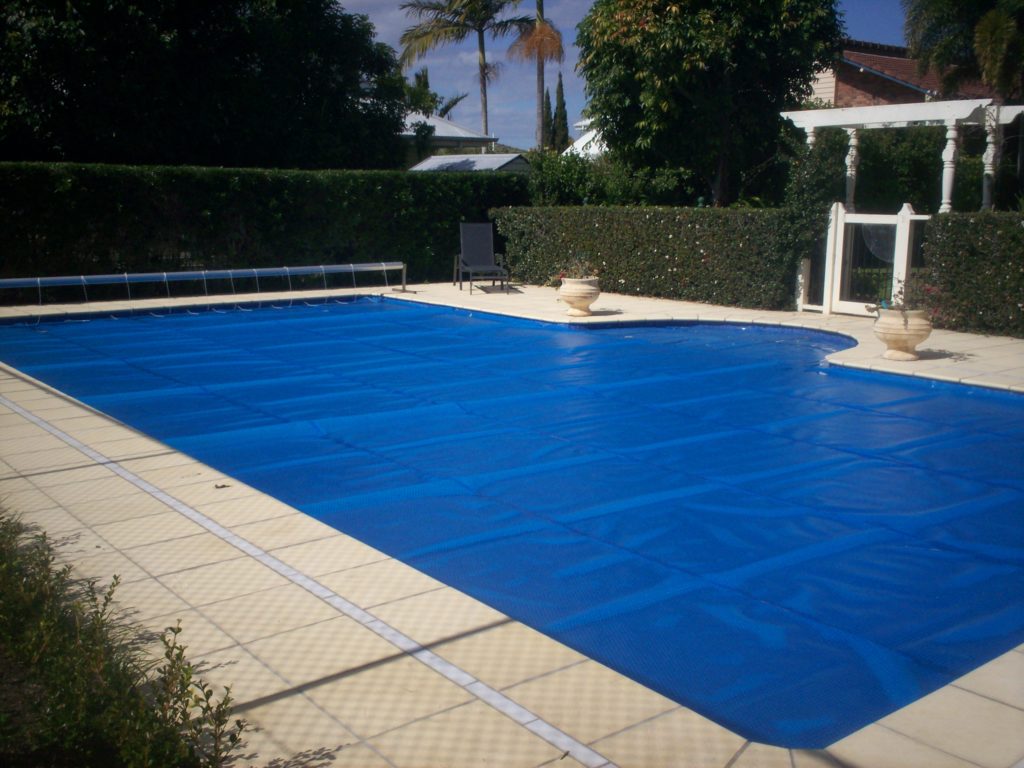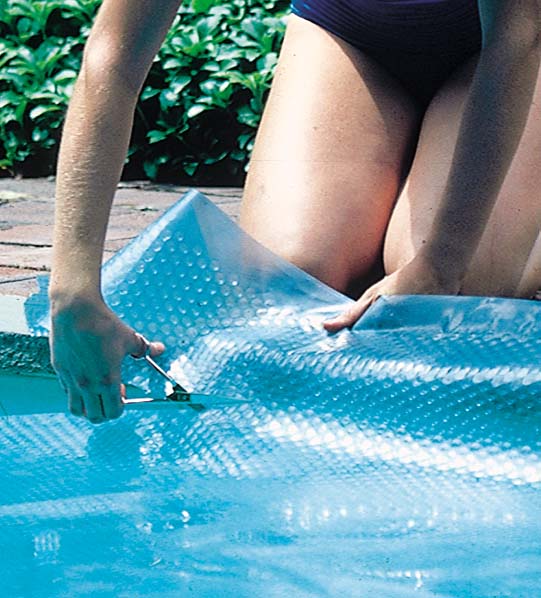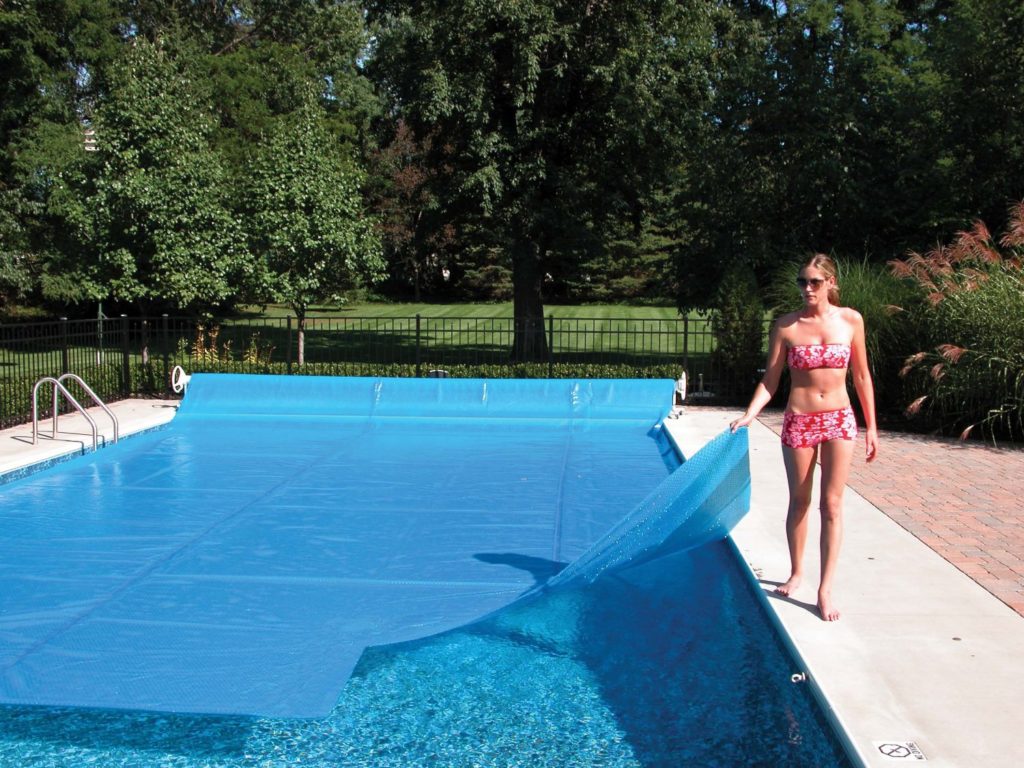If you own a pool, then chances are you’ve heard of solar pool covers. And if you haven’t, then all the more reason to continue reading.
Why?
Because solar pool covers are one of the most useful tools at a pool owner’s disposal. They save energy, time, and money. Of course, if you’re reading this, then you’re probably already thinking about buying one.
But if not, this post will still fill you in on everything you need to know about solar pool covers. From how they work, to the multitude of benefits that come with using them. With that said, here’s a simple guide on how to use a solar pool cover.
How To Use A Solar Pool Cover



What is a solar pool cover
A solar pool cover, or solar blanket, is a thin and lightweight sheet made from a special UV resistant plastic. Each blanket is double-sided, with one side smooth and the other similar to bubble wrap.
Just like a regular lid on a pot, covers trap in heat and reduce evaporation while shielding unwanted debris from entering your water.
Now that may not sound like a huge deal, but consider that 75% of heat loss is due to evaporation. A pesky, yet avoidable problem that every uncovered pool is subject to. One that’s easily resolved by using a solar pool cover.
How does a solar pool cover work?
As you pool sits out under the hot rays of the sun, it naturally collects solar heat. Hence why your water is always warmest on the sunniest, hottest days of the year.
But seldom is that natural heat enough to provide a steady, comfortable swim throughout the year. This is why many pool owners invest in a pool heat pump — they’re a reliable source for on demand heat. Yet even with the best pool heater, evaporation is still a major problem.
That is until you apply a solar pool cover. A solar pool cover creates a barrier between the surface of your pool water and the atmosphere. Just like we mentioned earlier, it’s a lot like putting a lid on a warm pot. Not only does it contain the heat, but it also helps it heat faster.
Without a cover, your water is free to evaporate into the atmosphere, burning away chemicals and losing heat rapidly.
But with a solar cover applied, any heat that would have been lost to evaporation stays contained in the water.
Here’s how to put one on your pool.
How to use a solar pool cover
For the most part, using a pool cover is as simple as “set it and forget it”. Of course, making sure to apply the cover correctly is critical, which is what this section is about.
When you open up a cover for the first time, it probably won’t be a perfect fit. Therefore, you’ll need to cut it to the right size.



Your pool cover should span the length and width of your water and your water only. To be clear, you don’t want any extra cover draped onto any of the ledges, as this greatly reduces the cover’s effectiveness and allows for evaporation.
So with that said, grab a pair of scissors and shape the cover to fit snuggle atop the surface of your water.
As you apply the cover, make sure the bubbled side is facing the water — the plastic air bubbles are what keep the cover afloat.
From there, your job is pretty much done. Simply remove and reapply the cover as needed.
When to use a solar pool cover
Any time you’re not swimming is an excellent time to use your solar cover. Especially if it’s nighttime when outside temperatures are lowest. This is when your pool will cool off the fastest, so always use the cover to hold onto that heat.
So overall, use it always, because who doesn’t want to save as much heat, water, and energy as possible?



Benefits of a solar pool cover
If you’ve read this far, then you already know that the main benefit of solar pool covers is their ability to improve your pool’s heat and water retention. But that within itself has a few other effects on your pool system, good ones though, of course.
A few important benefits of using a solar pool cover include:
- Less pool maintenance: covers help keep debris out of your pool
- Better energy efficiency: solar covers conserve heat reducing the need to run your pool heater
- Less chemical use: shields your water from harsh UV rays that burn away pool chemicals
- More comfortable swims throughout the year
[Want to save even more energy? Check out these energy saving tips for your swimming pool]
Alternatives to solar pool covers
If you aren’t quite ready to purchase a solar cover, consider one of the alternatives.
Liquid Pool Covers
You wouldn’t think that you could reap the same benefits with a liquid solar cover as you could with a physical cover. But surprisingly enough, liquid pool covers are nearly as effective as traditional solar covers when it comes to heat retention. And in case you were wondering, yes they’re non-toxic and perfectly safe for swimmers.
That said, the main drawback of using a liquid cover is that it can’t shield your water from unwanted debris. Also, consider that liquid pool covers need to be reapplied, or in other words, repurchased.
Solar Rings
Solar rings are pretty much solar pool covers but broken up into smaller rings, or circles, that connect magnetically. They won’t cover your water as snug as a traditional cover, but you only need as many as it takes to cover the surface. So in the end, they may end up being a little bit less, or more than the cost of a regular cover.
How to make your solar pool cover more effective
There are a few other ways to take advantage of solar power while improving the effectiveness of your solar cover.
+Use an energy-efficient pool heater
Pool Heat Pumps
Although pool heat pumps don’t actually collect solar energy with panels, they do harness solar heat. In fact, the hotter it is, the better a pool heat pump performs. This is because they use an evaporator coil and fan to draw in natural heat, then convert into a hot gas for heating your water.
Learn more: How Pool Heat Pumps Work
Solar Pool Heaters
Solar pool heaters use fixture of panels installed on a roof, coupled with a strong pool pump. As the panels collect energy (heat) from solar rays, the pump sends water to the roof, where it passes through the fixture’s heated tubing and back into the pool.
Of course, most solar pool heater owners know that without steady sunlight, consistent heat isn’t likely. Hence why many of them use solar pool heaters and pool heat pumps together. This pool heater combination is, is the most reliable AND energy efficient pool heating option available.
Read more about it here: Pool Heat Pumps vs Solar Pool Heaters
+Use an automatic timer
Ever wondered what happens on the days you leave the cover on but forgot to run the rest of the pool system? In short, heat loss. That’s what happens, and lots of it.
Of course, with an automatic timer, you never have to worry about any of that. With just a few adjustments, an automatic timer can be set activate on a set schedule, powering up your heater and pump even when you’re away.
+Use a windshield
You know what increases evaporation? An increase in surface area.
And there’s only one thing that can increase your pool’s surface area: movement.
But even if there are no swimmers in the pool, and the cover is applied, there’s still one factor to account for. And that factor is good ole mother nature.
Specifically, the wind.
As the wind blows across the surface of your pool water, it creates small waves and ripples. Although appearing small, these waves greatly increase your water’s surface area.
So the best way to combat the wind is to simply block it. Most pool owners make use of pool enclosures to accomplish this. Of course, anything that can reliably shield your pool from the elements is a step in the right direction.


